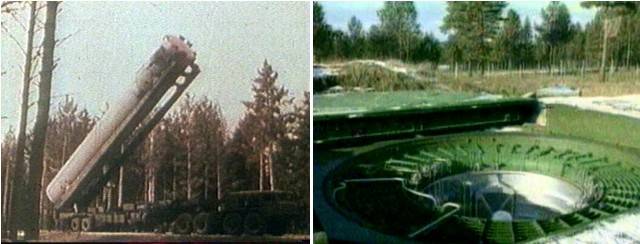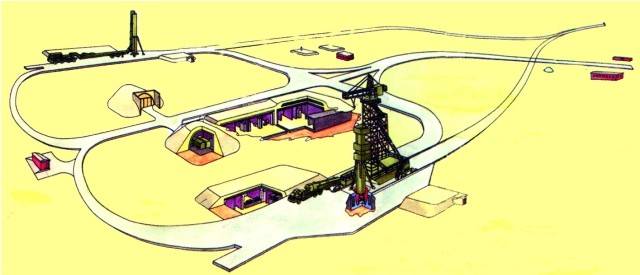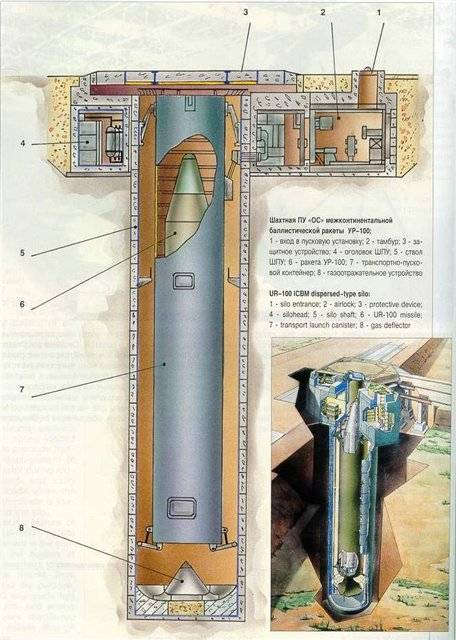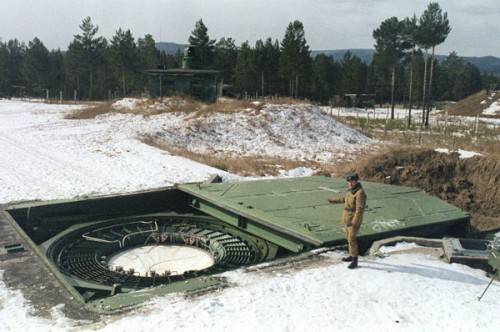UR-100: as General Secretary Khrushchev chose the most massive rocket strategic missile (part 2)
Thus, in fact, the fate of the future “Soviet Minitman” was decided - the first in stories USSR light intercontinental ballistic missile ampoule type. The word of the then Secretary General of the Central Committee of the CPSU, Nikita Khrushchev, determined the outcome of the rivalry between Yangel and Chelomey - at that stage. Here is how it looks in documents.

Loading missiles 8K84 in TPK in the mine launcher and view of the top of the mine with an open protective device. Photo from http://www.arms-expo.ru
23 March 1963, the Central Committee of the CPSU went to the accompanying letter to the draft resolution on the start of work on a "light" intercontinental ballistic missile. It was signed by Sergey Vetoshkin, Deputy Chairman of the Government Commission on Military Technical Issues (the second person in this department after Dmitry Ustinov), Marshal Rodion Malinovsky, Head of the State Committee on Aviation Industry Pyotr Dementyev, Chairman of the State Committee for Radio Electronics Valeriy Kalmykov, Chairman of the State Committee on Environmental Protection (in charge of the entire atomic industry) Yefim Slavsky, Commander-in-Chief of Air Defense Marshal Vladimir Sudets and two more marshals - Sergey Biryuzov and Matvey Zakharov, the first of whom was then commander-in-chief of the Strategic Missile Forces and literally in a few days changed l as the second, who held the post of Chief of the General Staff of the Armed Forces of the USSR. This was how its text was:
“Owls. top secret
Central Committee of the CPSU
In accordance with the order of the CPSU Central Committee, we present the draft Resolution on the development in OKB-52 of the State Committee of the USSR Council of Ministers for aviation automated missile system technology with a universal ampoule-type UR-100 product with a simplified mine launch.
The proposal for the development of the UR-100 complex was presented by designers TT. Chelomey, Pilyugin, Ryazan, Kosberg, Mintz and Raspletin.
The UR-100 missile is being developed as a universal missile for ground targets and for the country's missile defense. The firing range of the UR-100 rocket with special charges at ground targets from 2000 km to 11 000 km. Accuracy of shooting at the maximum range ± 3 km. The start time for joint testing is IV kV. 1964
The draft resolution is attached.
The project, which was attached to this letter, was only a week later reviewed at a meeting of the Presidium of the Central Committee of the CPSU and adopted almost unchanged, becoming the famous joint resolution No. 389-140 of the Central Committee of the CPSU and the Council of Ministers of the USSR. It is also worth it to bring it with small bills:
"Special folder
Ow. top secret
Of particular importance
Central Committee of the CPSU and the USSR Council of Ministers
from 30 March 1963 g. No 389-140
On the creation of the missile complex UR-100
Attaching particular importance to the armament of the Soviet Army with ampoule-type missiles with a simplified mine start, the CPSU Central Committee and the USSR Council of Ministers agree:
To accept the proposal of GKAT (tt. Dementieva, Chelomey), the State Committee for the RE of the USSR (tt. Kalmykov, Pilyugin, Ryazan) and the USSR Ministry of Defense (tt. Malinovsky, Biryuzov), reviewed and approved by the commission of the USSR Supreme Economic Council on military-industrial issues, on the development of 1963 – 64 of an automated missile complex with a universal UR-100 ampoule type with a simplified shaft launch with the following main characteristics:
longest firing range without taking into account the rotation of the Earth - 11 000 km
minimum… - 2000 km
control system - autonomous with radio correction
maximum deviation when shooting at the maximum range:
at autonomous SU
- in range - ± 5,5 km
- in the direction - ± 3,0 km
with radio correction
- in range - ± 3,0 km
- in the direction - ± 3,0 km
special charge with automation, initiation system, contact and proximity sensors
the longest distance - 11000 km
to the minimum ... - 2000 km
starting weight of the product —35 t
engine — liquid
fuel:
- fuel - dimethylhydrazine
- oxidizer - anhydrous nitrogen tetraxide
Storage of a product filled with fuel components in a mine starting position in readiness No. 1 - 7 – 10 years;
Willingness No. 1 automated complex to start on a pre-planned goal from the moment of receiving a command to start - 3 minutes;
Start type - mine automated
Start security - 2,5 kg / sq. Cm. in the shock wave front ...
The development of a universal missile UR-100 lead as a ballistic missile to destroy ground targets, and for the missile defense of the country.
Set the start date for joint testing of the complex with the UR-100 product - IV sq. 1964
Approve the main performers of work:
on the system as a whole and the ballistic missile UR-100 - OKB-52 GKAT USSR (General Designer t.Chelomei)
To oblige the Ministry of Defense of the USSR (tt. Zakharov, Biryuzov) to issue within a month, and the USSR Atomic Forces Group of Companies, the USSR GO of the USSR within a month to consider and coordinate with the USSR Ministry of Defense tactical and technical requirements for the development of a product complex. ”
Ballistic missile cartridge
This was how the fate of the future most massive intercontinental ballistic missile of the Soviet Rocket Forces, the famous "hundred", was decided. Alas, the development of OKB-586 under the leadership of Mikhail Chelomey, the “light” intercontinental rocket P-37, has sunk into oblivion. The sunk, despite repeated requests from the designer to the Central Committee of the CPSU and personally to Nikita Khrushchev, asking him to fulfill the promise made in the winter of 1963 in the heat of the year and allow him to refine not one system but two. However, soon Khrushchev himself turned into a pensioner of union importance, and Leonid Brezhnev, who took his place, had nothing to do with that promise.

Launch pad at the Baikonur test site, from which the first ground launches of the UR-100 were carried out. Photo from http://www.arms-expo.ru
And the top-level UR-100 rocket was quickly brought to embodiment in the metal and was put to the test. They started on 19 on April 1965 of the year at the Tyura-Tam test site (Baikonur) by launching from a ground-based launcher. Three months later, 17 July, carried out the first launch of the silo launcher, and only until the end of the test, that is, before 27 October 1966, the new rocket managed to make 60 launches. As a result, the Soviet Strategic Missile Forces received a “light” intercontinental ballistic missile with a launch mass of 42,3 tons, of which 38,1 tons accounted for fuel, two warhead types - 500 kilotons or 1,1 megatons and a range of 10 600 km (with a “light” headpiece) or 5000 km (with "heavy").
While UR-100 was learning to fly, the OKB-52 affiliates worked on creating the appropriate infrastructure. The branch №2 of the design bureau, created immediately after the decision to develop the "weave", began working on the creation of a transport and launch container (TLC) for it. After all, the rocket was not only to be ampulized, that is, it was refueled directly at the factory - it had to be installed in the mine as quickly and simply as possible and did not require any complicated maintenance work. This could be achieved by solving two problems. The first is to eliminate the possibility of leakage and mixing of high-boiling fuel components, which the designers have achieved by installing diaphragm valves between the fuel tanks and the propulsion system. And the second is to provide the most simple and automated service, for which a fully assembled and loaded rocket was placed at the plant directly at the plant, which UR-100 left only at the time of launch (or butchering).
This container was one of those unique technical devices that provided the UR-100 with long military service. After the rocket took its place in TPK, it was sealed with a special film on top - and the “weaving” no longer had contact with the environment, remaining inaccessible for corrosion and other dangerous chemical processes. All further actions with the rocket were carried out exclusively remotely - through four special connectors in the container in which the wires of the external control and monitoring system and gas communications were connected for pre-launch pressurization of the fuel tanks with compressed nitrogen and air.
Another technical innovation was the “separate start” system, in which each silo launcher for the UR-100 defended itself from the others at a distance of several kilometers. If we take into account that a single rocket regiment, armed with the 15P084 complex with the 8K84 rocket (“weave” army cipher), it becomes clear that even a nuclear strike against the location should not have destroyed more than a pair of silos, allowing the rest strike back.

Layout of the 8K84 rocket in the mine launcher of a separate launch. Photos from http://kollektsiya.ru
The UR-100 mine launcher itself was a mine of 22,85 depth m and 4,2 diameter m, into which a sealed TPK with a missile was placed with a special installer. The mine had a cap where the ground test-starting equipment and batteries were located, and was closed with a heavy lid with a diameter of 10-11 m, which moved off along the rails. Next to one of these mines was located a command post of pit type, that is, built in a foundation pit specially opened for it and assembled directly on the spot. Such a KP was, unfortunately, much less protected from the effects of nuclear weapons adversary, and it disappointed the military. After all, if the UR-100 missile silo could even withstand a nuclear explosion at a distance of up to 1300 meters from the installation, then what was the use of it, if the same explosion destroyed the command post - and there was simply no one to give the command “Start!” Therefore, in the future, in the design bureau of heavy machinery, a universal shaft-type gearbox was developed, which was located in a mine similar to a missile - and had almost the same protection.
Another technical innovation applied in the UR-100 rocket was the in-flight correction system. By tradition, individual small engines were responsible for this, requiring a separate fuel supply and control system. At the "weave" the question was decided differently: the main engines, whose nozzles could deviate in the horizontal plane by several degrees, were responsible for changing the course during the flight at the first stage. But there were enough of them, so that the rocket could return to the necessary course if it had lost it, following the command of the inertial guidance system. But the second stage was equipped with a separate four-chamber steering engine, as usual.
Not for missile defense and not for the sea
Even before the UR-100 rocket was put to the test, the Khrunichev Moscow Machine-Building Plant began its mass production, following the procedure established in the Soviet Union, since it was necessary to take missiles somewhere for testing. And after the resolution of the USSR Council of Ministers of 21 on July 1967, the combat missile system with the 8K84 rocket was adopted for use by the Strategic Missile Forces, the issue of "weave" was also established at the Omsk aircraft factory No. 166 (production association Polet) and the Orenburg aircraft factory No. 47 ( Production Association "Strela").

Mine missile launcher of the UR-100 with an open protective device; clearly visible sealing film on TPK. Photos from http://militaryrussia.ru
And the first missile regiments, armed with the new complex, rose to combat duty eight months before its official adoption. These were divisions deployed under the settlements of Drovyanaya (Chita Region), Bershet (Perm Region), Tatishchevo (Saratov Region) and Gladkaya (Krasnoyarsk Territory). Later, rocket divisions were added to them near Kostroma, Kozelsky (Kaluga region), Pervomaisk (Nikolaev region), Teikovo (Ivanovo region), Yasnoy (Chita region), Svobodny (Amur region) and Khmelnitsky (Khmelnitsky region). The total maximum size of a group of missiles UR-100 in 1966-1972 was up to 990 missiles that were on duty!
Later, the first modifications of the UR-100 began to give way to a newer, with improved performance and new combat capabilities. The first was the UR-100М (aka the UR-100UTTH): it has improved the control system compared to the first one, improved the reliability of the lightweight head section, installed a set of means to overcome the missile defense systems. The next was the UR-100K, which surpassed the previous modifications in firing accuracy, engine life and the payload mass that grew by 60%, as well as in reduced pre-launch preparation time and range, which reached 12 000 km. And the last modification was the UR-100U, which, firstly, received a scattering-type warhead (that is, divided without self-targeting of each unit) of three blocks of 350 kilotons each. And although this reduced the range to 10 500 km, the combat effectiveness increased due to the dispersing warhead.
The first UR-100 took up combat duty in 1966 year and were removed from it in 1987, then UR-100М served from 1970 to UR-100K from 1971 to 1991, and UR-100K stood on combat duty from 1973 of the year to 1996, while the last missiles of this type, NATO code-named Sego - that is, the lily of Kalohortus Nuttal (which, by the way, is a symbol of the state of Utah), were removed from combat duty and eliminated in accordance with contract OSV-2.

The transport vehicle with the UR-100 rocket in the variant of the anti-missile missile defense system Taran. Photo from http://www.nt-magazine.ru
But the variants of using the UR-100 as an anti-missile and sea-based missiles conceived by Vladimir Chelomey did not work out. Work on the first project, called the missile defense system "Taran", turned in 1964 year. Alas, the idea of intercepting American warheads in a confined space, through which, according to the developers, almost all trajectories of attacking missiles pass, turned out to be utopian. And the matter was not the impossibility of organizing interception: for this, the capabilities of the radar station TSO-P and located in the half a thousand kilometers from Moscow and the radar detection posts RO-1 and RO-2 (respectively in Murmansk and Riga) should have been enough. The problem was the power of nuclear warheads, which were planned to be used as antimissiles on the UR-100. In particular, Grigori Kisunko, the developer of the first national missile defense system for B-1000, recalls how Sergey Korolev told him: “I spoke with Keldysh, his guys figured it out, given that Americans are not such fools as they report to Nikita Sergeevich: to destroy 100 “One minute” each “Minuteman” warhead will require spending at least 200 “Taran” anti-missile on 10 megatons - total nuclear illumination in 2000 megatons! ”. Apparently, as a result, these calculations were brought to the notice of the Soviet government, and the topic “Ram” was closed by a personal order of Nikita Khrushchev, given shortly before his dismissal.
And from the sea base of the UR-100 within missile complex submarines D-8 had to be abandoned due to the fact that the adaptation of the “land” missile to the launch from the submarines of the “Skat” project, which was developed specifically for them, or the unique submersible launch facility of the 602 project carried with them more difficulties than benefits. The dimensions of even a “light” intercontinental ballistic missile adapted to launch from a silo launcher were too large. Alteration of it for other dimensions in terms of complexity and labor costs was comparable to the development of a new special sea-based missile. What, in fact, it was decided to do after the D-8 project in the middle of 1964, it was decided to close.
Information